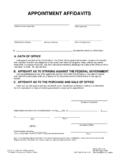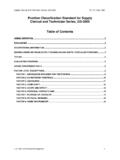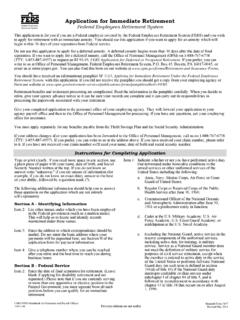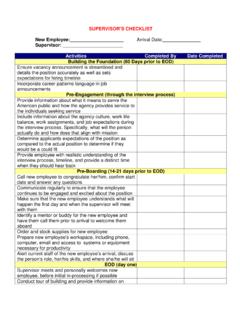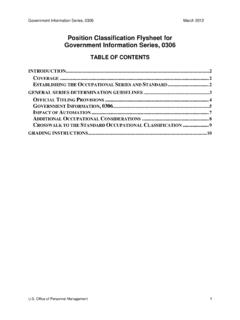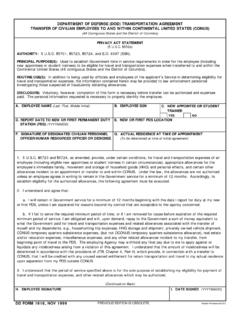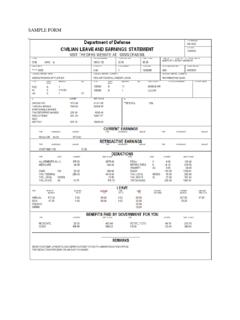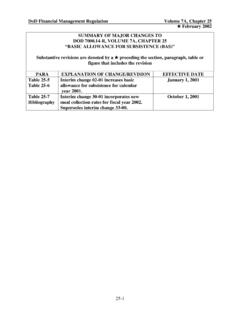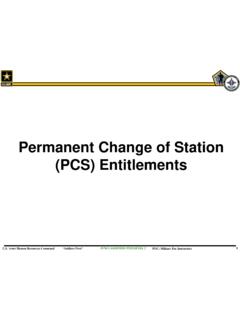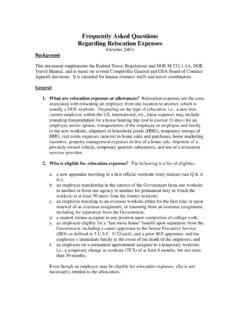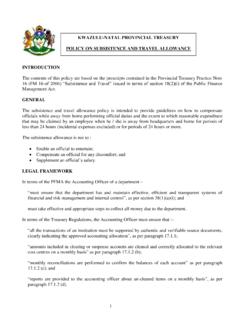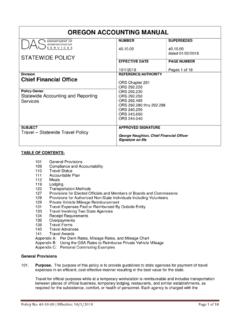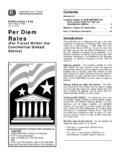Transcription of Handbook on Pay and Leave Benefits for Federal Employees ...
1 U NITED STATES O FFICE OF PERSONNEL M ANAGEMENT. Handbook on Pay and Leave Benefts for Federal Employees Afected by Severe Weather Conditions or Other Emergency Situations SEPTEMBER 2021. Handbook On Pay and Leave Benefits For Federal Employees Affected By Severe Weather Conditions or Other Emergency Situations TABLE OF CONTENTS. Page I. Pay and Leave Benefits For Employees Prevented From Working In an Area Affected By Severe Weather Conditions or Other Emergency Situations .. 1. II. Pay and Leave Benefits For Employees Required To Work In an Area Affected By Severe Weather Conditions or Other Emergency Situations .. 7. III. Other Pay and Leave Benefits .
2 15. 1. I. Pay and Leave Benefits For Employees Prevented From Working In an Area Affected By Severe Weather Conditions or Other Emergency Situations Weather and Safety Leave Weather and safety Leave is provided at an agency's discretion for such events related to the closure of the official Federal worksite due to natural disasters, such as: hurricanes, tornadoes, floods, wildfires, earthquakes, landslides, snowstorms, or during building specific emergencies such as a fire or power outage. While there are no specific time limitations on the amount of weather and safety Leave that an agency may provide, the use of this authority should be aligned with the nature of the emergency During the period an employee is provided weather and safety Leave , an agency should be planning for the return of its Employees back to a work status, either at the office duty location or at an alternative location approved by the agency.
3 During a weather or safety-related event that affects a Federal duty station (or the surrounding commuting area), Employees who participate in an agency's telework program may still be able to telework at a designated alternative worksite (most typically the employee's home). As long as the designated approved telework site is functional, the employee may be required to telework, or request to be absent from duty (either paid Leave or Leave without pay) if he/she chooses not to perform work, unless one of OPM's regulatory exceptions permitting the use of weather and safety Leave applies. Specifically, agencies may provide weather and safety Leave to a telework program participant if, in the agency's judgment, the employee could not have reasonably anticipated the severe weather or emergency and thus is not prepared to telework.
4 (See 5 CFR (a)(2)(i).). Additionally, agencies may provide weather and safety Leave to a telework program participant if the employee is prepared to work at the telework site but is prevented from safely working there due to the severe weather or emergency situation. (See 5 CFR. (a)(2)(ii).). Employees on preapproved Leave should continue to be charged Leave until the date they were scheduled to return to duty. Payments For Employees Ordered To Evacuate Executive agencies may authorize advance payments, evacuation payments, and payments for travel and subsistence expenses to Employees who are ordered to evacuate from an area because of imminent danger to their lives as a result of a severe weather condition or other emergency situation.
5 The head of an agency or designated official must make the determination that an employee was officially ordered or authorized to evacuate. Agencies must follow the regulations in 5 CFR part 550, subpart D, for evacuations from or within the United States and certain nonforeign areas. Advance Payments An agency may make an advance payment to an employee who has received an order to evacuate, provided that, in the opinion of the agency head or designated official, payment 2. in advance of the date on which the employee otherwise would be entitled to be paid is required to help the employee defray immediate expenses incidental to the evacuation.
6 An authorized agency official must determine the time period (measured in days) to be used in computing the amount of the advance payment. The selected time period may not exceed 30 days. The agency must determine the days and hours the employee would have been expected to work during the selected time period (but for the evacuation) as follows: (1) for Employees with a regularly scheduled tour of duty, the agency must determine the days and hours in the employee's normal basic workweek during the selected time period; and (2) for intermittent Employees , the agency must estimate the days and hours the employee would have been expected to work during the selected time period (not to exceed 80 hours in a biweekly pay period).
7 If possible, the agency should estimate an intermittent employee's projected days and hours of work based on a 6-week average. An agency must compute the advance payment based on the projected workdays and work hours in the selected time period and on the rate of pay (including any applicable allowances, differentials, or other authorized payments) to which the employee was regularly entitled immediately before the issuance of the evacuation order. An employee is considered to be regularly entitled to night pay differential and Sunday premium pay for applicable hours in the employee's normal basic workweek. Also, an employee is considered to be regularly entitled to law enforcement availability pay, administratively uncontrollable overtime pay, standby duty premium pay, regular overtime pay for firefighters covered by 5 5545b, retention payments under 5 5754, physicians' comparability allowances, and supervisory differentials, as applicable.
8 Agencies must make all deductions from advance payments that are authorized by law, including retirement or Social Security (FICA) deductions, authorized allotments, and income tax withholdings. An employee's receipt of an advance payment may not affect the amount of the evacuation payments otherwise due the employee even if the advance payment was calculated based on a period of time that is covered by one or more evacuation payments. An advance payment is equivalent to a loan and must be treated as a debt owed to the Federal Government. However, an authorized agency official may waive recovery of an advance payment when he or she determines that recovery would be against equity or good conscience or against the public interest.
9 (See 5 5522(c).). Evacuation Payments While an evacuation order is in effect, an agency may make evacuation payments to an affected employee who is prevented from performing the regular duties of his or her position (as if the employee had continued to perform those regular duties). The agency should make these payments on the employee's regular pay days when feasible, since evacuation payments reflect the employee's regular pay. Evacuation payments are not treated as a debt owed to the Federal Government. 3. The agency must determine the days and hours the employee would have been expected to work during the selected time period (but for the evacuation) as follows: (1) for Employees with a regularly scheduled tour of duty, the agency must determine the days and hours in the employee's normal basic workweek during the selected time period; and (2) for intermittent Employees , the agency must estimate the days and hours the employee would have been expected to work during the selected time period (not to exceed 80 hours in a biweekly pay period).
10 If possible, the agency should estimate an intermittent employee's projected days and hours of work based on a 6-week average. An agency must compute the evacuation payment based on the projected workdays and work hours in the selected time period and on the rate of pay (including any applicable allowances, differentials, or other authorized payments) to which the employee was regularly entitled immediately before the issuance of the evacuation order. An employee is considered to be regularly entitled to night pay differential and Sunday premium pay for applicable hours in the employee's normal basic workweek. Also, an employee is considered to be regularly entitled to law enforcement availability pay, administratively uncontrollable overtime pay, standby duty premium pay, regular overtime pay for firefighters covered by 5 5545b, retention payments under 5 5754, physicians' comparability allowances, and supervisory differentials, as applicable.

